|
|
|
Sort Order |
|
|
|
Items / Page
|
|
|
|
|
|
|
| Srl | Item |
| 1 |
ID:
138414
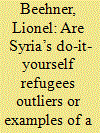

|
|
|
|
|
| Summary/Abstract |
Refugee camps are often treated as incubators of social unrest, violence, terrorism, and illicit trade. This provokes their overseers in the United Nations (UN) and other relief agencies to conduct frequent social engineering to enhance the camps’ legibility. Hence, we see orderly, perpendicular rows, standardized units from redistricting to the allocation of diapers, and so forth—all of the follies of high modernism that James Scott predicted in "Seeing Like a State," but writ small. Indeed, my qualitative research from the Za’atari refugee camp, located in Jordan along the Syrian border, indicates that refugees, especially middle-class ones like Syria’s, rebel against uniformity—or what Scott describes as “metis”—and seek to recreate their domiciles as best they can from the meager canvas tents and campers allotted to them. Put simply, they see their surroundings more as the disorderly “sidewalk ballet” of Jane Jacobs’ Greenwich Village than the high modernist yet sterile functionalism of Robert Moses. This holds important policy implications for the future of how we devise refugee camps, which increasingly resemble small cities; how we settle internally displaced persons (IDPs); and how we deal with the aftermath of mass population displacements. From direct cash transfers to the districting of refugees, some bureaucratic flexibility is required but so is an acknowledgement and embrace of refugees’ do-it-yourself ethos that is rooted in their resistance to authority and trauma from violence. Drawing from the literature in social anthropology and political science, this article presents new evidence from Za’atari that disputes the utility of a high modernist approach to the social engineering of large displaced populations.
|
|
|
|
|
|
|
|
|
|
|
|
|
|
|
|
| 2 |
ID:
154276
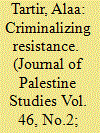

|
|
|
|
|
| Summary/Abstract |
The Palestinian Authority (PA) adopted donor-driven security sector reform (SSR) as the linchpin to its post-2007 state-building project. As SSR proceeded, the occupied West Bank became a securitized space and the theater for PA security campaigns whose ostensible purpose was to establish law and order. This article tackles the consequences of the PA’s security campaigns in Balata and Jenin refugee camps from the people’s perspective through a bottom-up ethnographic methodological approach. These voices from below problematize and examine the security campaigns, illustrating how and why resistance against Israel has been criminalized. The article concludes by arguing that conducting security reform to ensure stability within the context of colonial occupation and without addressing the imbalances of power can only ever have two outcomes: “better” collaboration with the occupying power and a violation of Palestinians’ security and national rights by their own security forces.
|
|
|
|
|
|
|
|
|
|
|
|
|
|
|
|
| 3 |
ID:
107197
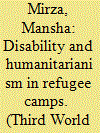

|
|
|
|
|
| Publication |
2011.
|
| Summary/Abstract |
There are an estimated 43.3 million forcibly displaced people around the world, many of whom live in refugee or internally displaced camps. These camps are disproportionately congregated in the developing world, making them a prevalent, yet often overlooked landscape in the global South. Among the scores of refugees living in refugee camps is a large number of people with disabilities. This article provides an overview of humanitarian practices and their guiding philosophies and how these address disability issues within the context of refugee camps. Examples of grassroots initiatives related to disability rights and disability inclusion within refugee camp settings are also provided. Using these examples, the paper makes the argument that refugee camps offer fertile grounds for the diffusion of a community-engaged, grassroots disability praxis across the humanitarian field and beyond.
|
|
|
|
|
|
|
|
|
|
|
|
|
|
|
|
| 4 |
ID:
127805


|
|
|
|
|
| Publication |
2014.
|
| Summary/Abstract |
Refugee camps are increasingly managed through a liberal rationality of government similar to that of many industrialized societies, with security mechanisms being used to optimize the life of particular refugee populations. This governmentality has encompassed programmes introduced by the United Nations High Commissioner for Refugees (UNHCR) and various non-governmental organizations (NGOs) to build and empower communities through the spatial technology of the camp. The present article argues that such attempts to 'govern through community' have been too easily dismissed or ignored. It therefore examines how such programmes work to produce, manage and conduct refugees through the use of a highly instrumentalized understanding of community in the spatial and statistical management of displaced people in camps. However, community is always both more and less than what is claimed of it, and therefore undermines attempts to use it as a governing tactic. By shifting to a more ontological understanding of community as unavoidable coexistence, inspired by Jean-Luc Nancy, we can see how the scripting of and government through community in camps is continually exceeded, redirected and resisted. Ethnographies of specific camps in Africa and the Middle East enable us both to see how the necessary sociality of being resists its own instrumentalization and to view the camp as a spatial security technology. Such resistance does not necessarily lead to greater security, but it redirects our attention to how community is used to conduct the behaviour of refugees, while also producing counter-conducts that offer greater agency, meaning and mobility to those displaced in camps.
|
|
|
|
|
|
|
|
|
|
|
|
|
|
|
|
| 5 |
ID:
098312


|
|
|
|
|
| Publication |
London, Routledge, 2010.
|
| Description |
viii, 262p.
|
| Standard Number |
9780415776950
|
|
|
|
|
|
|
|
|
|
|
|
Copies: C:1/I:0,R:0,Q:0
Circulation
| Accession# | Call# | Current Location | Status | Policy | Location |
| 055196 | 327.1/BIS 055196 | Main | On Shelf | General | |
|
|
|
|
| 6 |
ID:
073827


|
|
|
|
|
| Publication |
2006.
|
| Summary/Abstract |
The global number of child soldiers has grown significantly in the last two decades despite a series of protocols designed to curb this trend. They are generally employed in wars where belligerents spend more time attacking civilian populations than fighting professional armies. Used by both governments and rebel groups, child soldiers epitomize many of the problems associated with states at risk: intergenerational violence, poverty, and the failure of efforts to instill the rule of war. Both scholars in security studies and policymakers have largely regarded child soldier recruitment as a humanitarian issue. But recent events have linked child soldiering to insurgency and terrorism, suggesting that this issue is also developing a security dimension. This article examines contrasting arguments about the causes of child soldiering. Using data drawn from nineteen African conflicts, the authors argue that the major explanation for the significant variation in the percentage of child soldiers recruited is the degree of protection against abduction provided by governments and external actors to camps housing internally displaced persons and refugees.
|
|
|
|
|
|
|
|
|
|
|
|
|
|
|
|
| 7 |
ID:
172906
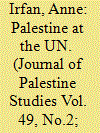

|
|
|
|
|
| Summary/Abstract |
This article examines the relationship of the Palestine Liberation Organization (PLO) to the United Nations Relief and Works Agency for Palestine Refugees in the Near East (UNRWA) during the 1970s, the period when the PLO reached the zenith of its power in Palestinian refugee camps throughout the Levant. Based on archival United Nations (UN) and UNRWA documents, as well as the PLO's own communications and publications, the article argues that the organization approached its relationship with UNRWA as part of a broader strategy to gain international legitimacy at the UN. That approach resulted in a complex set of tensions, specifically over which of the two institutions truly served and represented Palestinian refugees. In exploring these tensions, this article also demonstrates how the “question of Palestine” was in many ways an international issue.
|
|
|
|
|
|
|
|
|
|
|
|
|
|
|
|
| 8 |
ID:
175797


|
|
|
|
|
| Summary/Abstract |
The camp and the city are both important for understanding the relationship between space and identity in the refugee experience of exile. In the Palestinian example, the camp has emerged as a potent symbol in the narrative of exile although only a third of refugees registered with UNRWA live in camps. Moreover, the city and urban refugees remain missing in most of the scholarship on the Palestinian experience with space, exile, and identity. Furthermore, there is little attention to how refugees understand the concept of the city and camp in their daily life. This article examines how Palestinian urban refugees in the Old City of Damascus conceptualized the relationship between the camp and the city. It illustrates how the concept of the camp remained necessary for the construction of their collective national identity while in Syria. However, the city was essential in the articulation of individual desires and establishing social distinction from other refugees. Thus, during a protracted exile it is in the interstice between the city and the camp, where most urban refugees in the Old City situated themselves, that informed their national belonging and personal aspirations.
|
|
|
|
|
|
|
|
|
|
|
|
|
|
|
|
| 9 |
ID:
044150
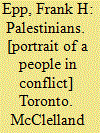

|
|
|
|
|
| Publication |
Toronto, Mcclelland and Stewart Ltd., 1976.
|
| Description |
240p.hbk
|
| Standard Number |
0771030991
|
|
|
|
|
|
|
|
|
|
|
|
Copies: C:1/I:0,R:0,Q:0
Circulation
| Accession# | Call# | Current Location | Status | Policy | Location |
| 016733 | 956.9404/EPP 016733 | Main | On Shelf | General | |
|
|
|
|
| 10 |
ID:
187769
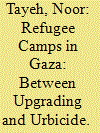

|
|
|
|
|
| Summary/Abstract |
This article examines the urban development of camps under humanitarian mandates in the context of the occupied Palestinian territories (oPt). The United Nations Relief and Works Agency for Palestine Refugees in the Near East (UNRWA) launched its Infrastructure and Camp Improvement Programme (ICIP) in 2007, with several pilot projects carried out to test this new approach. Using Gaza’s Deir El-Balah refugee camp as a case study, this article explores the contradictions inherent to development under humanitarianism and what Ilana Feldman has called “punctuations” in a chronic context of siege and infrastructure violence. That context, the article argues, perpetually sets the refugee communities back, eroding whatever capacities they were able to build up through their own collective efforts and through the aid of which they have been recipients for decades. Compounded by UNRWA’s perpetual funding shortage, the limits of development under the humanitarian umbrella within the context of a technocratic apolitical mandate become even more apparent.
|
|
|
|
|
|
|
|
|
|
|
|
|
|
|
|
| 11 |
ID:
153416
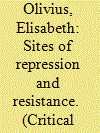

|
|
|
|
|
| Summary/Abstract |
Refugee camps are frequently perceived as spaces of emergency and exception. However, they are also spaces where millions of people live their everyday lives, sometimes for extended periods of time. As such, refugee camps are political spaces where struggles over the right to influence life in the camps and shape how they are governed are continuously ongoing. In this context, what are the opportunities for political participation for refugees living in camps? How and to what extent are refugees able to carve out political space where they can engage with and affect their lives and their situations? This paper addresses these questions through an analysis of refugee camps in Thailand. Drawing on Foucauldian analytics, the analysis demonstrates how key strategies employed to govern refugees, namely spatial confinement and development interventions are also creatively subverted by refugees and appropriated as bases for resistance and political mobilization. The article provides new insights into the relationship between power and resistance, demonstrating how specific technologies of governance create opportunities for subversion, reinterpretation, and appropriation.
|
|
|
|
|
|
|
|
|
|
|
|
|
|
|
|
| 12 |
ID:
163395
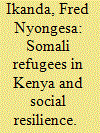

|
|
|
|
|
| Summary/Abstract |
Refugee camps are often perceived as unproductive places that waste people’s potential. What is left unremarked in many refugee accounts, however, is the positive side of camps. Highlighting suffering alone raises academic curiosity as to what keeps camps in protracted situations going for so long. Drawing on the notion of social resilience, this article highlights the multidimensionality of camps as social worlds by showing how the attachment through kin-based networks between Somalis at Dagahaley refugee camp in Kenya and their relatives in diaspora animated collective imaginaries about better futures in Minnesota. The article contributes to migration and humanitarian debates by arguing that refugee longings for onward migration is linked to places with a potential for kin-based support as opposed to random Western destinations, as is often highlighted in the media.
|
|
|
|
|
|
|
|
|
|
|
|
|
|
|
|
|
|
|
|
|